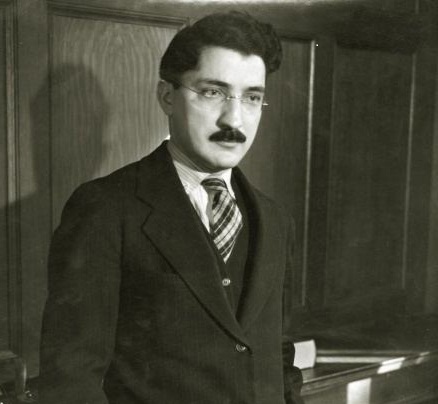D’Arcy McNickle, Novelist, Bureaucrat, Activist

For many people in the academic world, one of the major foundations of Native American literature was laid with the publication of The Surrounded in 1936. This novel, written by D’Arcy McNickle, was not the first novel written by an Indian nor was it particularly successful at the time. The book came out in the midst of the depression and found relatively little readership in spite of good reviews. In the 70 years that have passed since the book’s publication, however, it has become one of the most widely read and studied American Indian novels.
D’Arcy McNickle grew up on the Flathead Reservation in western Montana. The reservation was created with the Treaty of Hellgate in 1855 in which the Flathead, the Pend d’Oreille, and the Kootenai gave up millions of acres of their land. From the viewpoint of the American government, the reservation was intended to confine not only the three tribes who signed the treaty, but other tribes as well, out of the way of the American settlers. The languages of the Flathead and the Pend d’Oreille are related and belong to the Salish language family and thus it is common to refer to these two tribes as the Salish. The Kootenai, on the other hand, speak a totally different language.
D’Arcy McNickle was neither Salish nor Kootenai. His mother was Canadian Cree: her parents, who considered themselves Métis, sought refuge on the Flathead Reservation following the 1885 Riel Rebellion in Saskatchewan. D’Arcy was born on the reservation in 1904 and was enrolled on the Flathead Reservation in 1905. Most sources refer to his tribal affiliation as Flathead and today the library at the Salish-Kootenai College is named for him.
Like many other Indian children during the first part of the twentieth century, he went to a reservation grade school and then transferred to an Indian boarding school. Chemawa Indian School, like most Indian boarding schools of the day, was run like a military academy. The students wore military uniforms and marched in formations. He would later recall that students at Chemawa were punished for speaking to each other in an Indian language.
Unlike many other Indian young people during the first part of the twentieth century, D’Arcy McNickle went to college. He attended what is now the University of Montana in Missoula where he majored in literature and history. While at the University, he joined the staff of the University’s literary journal The Frontier in which he published poetry and short stories.
While D’Arcy learned a great deal at the University, he did not do well in his courses and did not graduate. His mentor, Harold G. Marriam, the head of the English Department, encouraged him to expand his horizons and suggested the possibility of earning his bachelor’s degree at Oxford.
The Flathead Reservation underwent allotment in 1910 and reservation land was divided among tribal members. The land which was left over was then declared surplus and opened to non-Indian settlement. As a tribal member, D’Arcy McNickle received an allotment. D’Arcy then sold his allotment so that he could go to England to attend Oxford University in 1925-1926.
In England, D’Arcy found that Oxford would not accept all of his academic credit. He thought that he needed only one more year to obtain his degree, but he found that it would take at least two. Since he did not have enough money to stay in England for two years, he did not enroll at Oxford. Instead, he attended lectures, explored the libraries, and took advantage of many opportunities to study on his own. Then he moved to Paris where he mingled with the expatriates of the “lost generation.” Overall, his European experience was not a happy one and he seldom referred to Oxford in later years.
Upon his return to the United States, he settled in New York and tried to find work as a writer. During one period of several months he moved to Philadelphia where he worked as an automobile salesman. Here he found that automobiles and high-pressure sales were the antithesis of his own personal values. He would later describe high pressure salesmanship as “unintelligent, wasteful, ruthless, animal, intent on driving every vestige of individual preference in matters of taste, modes of living, and cultural pursuits out of existence.” After seven months he returned to New York more determined than ever to make his way in the publishing field. Here he did a variety of free-lance jobs, including writing, proofing, and book make-up.
While in New York, D’Arcy enrolled at Columbia University where he studied American history. However, with the pressures of trying to earn a living he never earned his degree.
While in New York, D’Arcy began work on his first novel. After completing it, he collected a pile of rejection slips from publishers who were not interested in bringing it out. In the meantime, he sold a story to Esquire who labeled him as their “discovery of the month.” However, the money from selling the story was not enough to live on.
In 1934, federal Indian policy in the United States changed dramatically. No longer was the emphasis on the forced assimilation of Indians into “mainstream” American life, but with the Indian Reorganization Act and the administration of Commissioner of Indian Affairs John Collier there was a respect for Indian culture. For the first time in American history, it was okay to be Indian. D’Arcy McNickle writes that the country now accepts
“the radical concept that the Indian race was not headed for early extinction.”
In 1935, D’Arcy applied for work with the Federal Writers Project (FWP) and was accepted. He moved to Washington, D.C. where the FWP assigned him to the Indian Office (Bureau of Indian Affairs or BIA). The following year, he went to work for the BIA.
At this time, the Bureau of Indian Affairs was shaking itself free of the advice and guidance of Christian missionary groups which had dominated U.S. Indian policy and was turning toward social scientists, particularly anthropologists, for guidance. The change in the BIA orientation was not without controversy: Christian missionaries labeled the new orientation as atheistic, anti-Christian, and communistic. It was not long before D’Arcy McNickle was drawn into this controversy.
The BIA put out a small newsletter, Indians at Work, and with D’Arcy’s writing background it was natural that he write for this publication. One of his articles was a review of the novel The Enemy Gods, written by non-Indian Oliver LaFarge. LaFarge had won the Pulitzer Price for his early novel about Indians, Laughing Boy. Soon after the publication of D’Arcy’s review of this book, it began being quoted at length as evidence of the BIA’s anti-Christian and pro-communistic orientation.
In his review, D’Arcy writes:
“A dead Indian, they would say, is better off than La Farge’s Myron Begay, at the moment when, frenzied by the cheap rascality of Christian soul-saving, he stood up in a kind of missionary pep-meeting and denied his Gods.”
In response to this statement, the missionaries write:
“Christians! Where are you, that by your silence you deny your Christ and abandon your wards to the onslaught of the atheistic-communistic program … designed to aid in the overthrow of this Government and the Christian religion in America?”
In their publications and in their testimony before Congress, the missionaries claim that the BIA is now an evil influence on young Indians such as D’Arcy McNickle, and is turning them away from Christianity.
His first novel, The Surrounded, set on the Flathead Indian Reservation, was published in 1936. In his entry on McNickle in the Encyclopedia of North American Indians, Bear Don’t Walk reports:
“Set on the Flathead Reservation, it raises the issue of cultural identity for its mixed-blood protagonist, Archilde Leon. It describes how misunderstandings between a tribal culture and that of encroaching outsiders can lead to tragedy.”
In his book Tribal Secrets: Recovering American Indian Intellectual Traditions, Robert Allen Warrior notes that the novel
“found only a limited readership at the time of its publication, but it remains the most widely read and studied American Indian work from the period before N. Scott Momaday.”
Religion professor Philip Jenkins, in his book Dream Catchers: How Mainstream American Discovered Native Spirituality, writes:
“This book builds on the traditional Western format, but it also delves into spiritual themes, and the conflict of values faced by modern Indians.”
One of the tasks assigned to D’Arcy McNickle was the implementation of the 1934 Indian Reorganization Act which allowed tribes to become self-governing with their own constitutions. In was generally felt that his Indian heritage would be helpful in overcoming the suspicions of the tribes regarding federal policies. One of the first tribes to reorganize under the Act was the Confederated Salish and Kootenai Tribes of the Flathead Reservation.
As a result of his working with the social scientists, D’Arcy wrote a number of non-fiction books about American Indians. The first of his non-fiction books was They Came Here First: The Epic of the American Indian which was published in 1949. This was the first historical survey of Indian-European relations written by a Native American. The book’s publisher promoted it heavily and within a few years it had gone through several printings.
He followed this with The Indian Tribes of the United States in 1962 and Native American Tribalism in 1973. Working with Harold Fey he wrote Indians and Other Americans which was published in 1959 and was expanded in 1970.
While working for the BIA, he helped organize a meeting in Chicago in 1944 which involved a number of prominent Indian leaders. Out of this meeting emerged the National Congress of American Indians (NCAI), which continues today as one of the major Indian organizations in the United States and which works to keep an Indian voice in Indian policy.
In 1951, he took the leadership in having the BIA sponsor a series of community development workshops for Indian leaders in Utah, Arizona, and Oklahoma. The workshops were intended to help tribal leaders discover the internal resources available to deal with tribal problems. While the workshops were a step in the right direction, they actually had little influence and failed to result in any local action.
While he was involved in helping to formulate and execute Indian policy he did not abandon his creative writing. His second novel, Runner in the Sun was published in 1954. Unlike The Surrounded, this novel is set in a time period before the European invasion. It did not sell well and was perceived as a children’s book. Most reviewers of adult fiction ignored it.
His third novel, Wind from the Enemy Sky, finished in 1976, reflects a great deal of his work with tribes such as the Mandan in the years following World War II.
D’Arcy McNickle resigned from the BIA in 1954. He moved his family to Boulder, Colorado and worked on a number of projects, including the Crown Point project in New Mexico to provide the Navajo with health care.
In 1965, the University of Saskatchewan asked McNickle to chair the new Department of Anthropology at their Regina campus. While he never graduated from college and did not have any formal academic degrees, he accepted the position.
His biography of Oliver La Farge, Indian Man: A Life of Oliver La Farge was published in 1971 and hit the book world with a massive thud. The reviews were less than favorable and it did not sell well.
D’Arcy McNickle died in 1977. He did not live to see his novel Wind from an Enemy Sky published or to see the republication of his first novel, The Surrounded. Both of these were released in 1978, a time in which American Indian literature was going through a renaissance. The Surrounded had now been out of print for forty years and was nearly unknown in the academic world. With its reprinting, many began to call it the most significant novel written by an American Indian prior to World War II.
In his brief biography of D’Arcy McNickle in Notable Native Americans, James Ruppert writes:
“As a writer, historian, activist, government project manager, community organizer, and university professor, McNickle’s career was as diverse as his accomplishments. His voice was heard in the halls of Congress and the halls of universities, in homes on the reservation and homes in urban America.”


